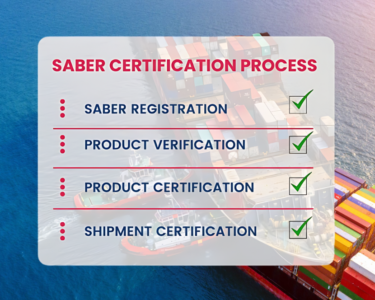The SABER certification process is a critical step for businesses looking to import and sell products in Saudi Arabia. While the system is designed to ensure that products meet the country’s strict safety and quality standards, navigating the SABER platform can present several challenges, especially for companies new to the process. This article explores the common hurdles businesses face during SABER certification, offers solutions and strategies for overcoming these challenges, and shares insights from companies that have successfully navigated the SABER process.
Identifying Common Challenges in the SABER Certification Process
The SABER certification process involves multiple steps, including product registration, conformity assessment, and the issuance of certificates. Throughout these stages, businesses may encounter several challenges:
1. Complexity of Regulatory Requirements
One of the most significant challenges in the SABER certification process is understanding and adhering to the complex regulatory requirements set by the Saudi Standards, Metrology, and Quality Organization (SASO). These regulations can vary depending on the product category, and staying up-to-date with the latest standards can be daunting for businesses.
2. Inaccurate or Incomplete Documentation
Accurate documentation is crucial for successful certification. However, many businesses struggle with gathering and submitting the necessary documents, such as technical data sheets, safety certifications, and test reports. Incomplete or incorrect documentation is one of the leading causes of delays and rejections in the SABER process.
3. Delays in Conformity Assessment
The conformity assessment, conducted by a Conformity Assessment Body (CAB), is a critical part of the SABER certification process. Delays can occur if the product requires extensive testing, if there is a backlog at the CAB, or if the product does not initially meet the required standards. These delays can disrupt business operations and lead to missed market opportunities.
4. Navigating the SABER Platform
For businesses new to the SABER system, navigating the online platform can be challenging. The process of registering products, selecting the appropriate CAB, and tracking the certification progress requires familiarity with the platform’s interface and functionalities. Without proper guidance, businesses may find themselves overwhelmed.
5. High Costs Associated with Certification
- The costs involved in the SABER certification process can add up, particularly for small businesses. These costs include fees for registering on the SABER platform, the conformity assessment, and any additional testing required to meet Saudi standards. Managing these expenses while ensuring timely certification can be a significant challenge.
- Solutions and Strategies for Overcoming SABER Certification Challenges
Despite these challenges, businesses can successfully navigate the SABER certification process by implementing the following strategies:
1. Stay Informed and Educated
Understanding the regulatory requirements is the first step in overcoming the complexity of the SABER certification process. Businesses should invest time in educating themselves about SASO standards relevant to their products. This can involve attending webinars, consulting with experts, or working with a knowledgeable compliance team to stay up-to-date with any changes in regulations.
2. Ensure Complete and Accurate Documentation
To avoid delays, businesses must ensure that all required documentation is complete, accurate, and up-to-date before submission. Creating a checklist of necessary documents for each product category can help in organizing the paperwork. Additionally, having a dedicated team member or external consultant review the documents before submission can help identify and correct any potential issues.
3. Choose the Right Conformity Assessment Body (CAB)
Selecting the right CAB is crucial for a smooth conformity assessment process. Businesses should choose a CAB that is reputable and has experience with the specific product category. Establishing good communication with the CAB can also help in understanding their requirements and timelines, reducing the risk of delays.
4. Utilize SABER Platform Resources
The SABER platform offers various resources, including user guides, FAQs, and customer support. Businesses should take advantage of these resources to familiarize themselves with the platform’s functionalities. Additionally, seeking help from a consultant or partner with experience in using the SABER system can provide valuable insights and assistance.
5. Budget for Certification Costs
To manage the costs associated with SABER certification, businesses should budget carefully and consider these expenses as part of their overall market entry strategy. Negotiating with CABs for cost-effective services, exploring discounts for multiple product registrations, and planning for potential additional testing costs can help in managing the financial impact.
Insights from Companies That Have Successfully Navigated the SABER Process
Several companies have successfully navigated the SABER certification process by adopting proactive strategies and leveraging expert knowledge. Here are some insights from these companies:
1. Collaboration with Local Partners
Many successful companies have collaborated with local partners in Saudi Arabia who are familiar with the regulatory landscape. These partners can provide valuable insights, help in navigating the SABER platform, and facilitate communication with SASO and CABs.
2. Early Preparation
Companies that start the certification process early often experience fewer delays. Early preparation includes gathering documentation, selecting a CAB, and understanding the requirements well before the product is ready for import. This proactive approach allows for sufficient time to address any issues that may arise during the certification process.
3. Continuous Monitoring of Compliance
Successful companies do not view SABER certification as a one-time event but as an ongoing process. They continuously monitor their products’ compliance with Saudi standards, even after certification. This involves staying informed about updates to SASO regulations and ensuring that any changes in product design or manufacturing are reflected in the certification.
The Importance of Preparation and Accurate Documentation
Preparation and accurate documentation are the cornerstones of a successful SABER certification process. By preparing early, businesses can ensure that they have all the necessary information and resources at their disposal, reducing the likelihood of delays and rejections. Accurate documentation, on the other hand, ensures that the product meets all the required standards and passes the conformity assessment without issues.
Key Takeaways:
- Start Early: Begin the certification process as soon as possible to allow time for addressing any challenges that may arise.
- Stay Informed: Keep up-to-date with SASO regulations and the specific requirements for your product category.
- Invest in Documentation: Ensure that all documentation is complete, accurate, and well-organized.
- Choose the Right Partners: Collaborate with reputable CABs and local partners to navigate the process more effectively.
- Monitor Compliance Continuously: View certification as an ongoing process, and stay vigilant about maintaining compliance.
Conclusion
The SABER certification process, while challenging, is essential for businesses looking to access the Saudi market. By understanding the common hurdles, implementing effective strategies, and learning from the experiences of successful companies, businesses can navigate the SABER system with confidence. Preparation, accurate documentation, and a proactive approach are key to achieving compliance and ensuring that products meet Saudi Arabia’s high standards for safety and quality.



